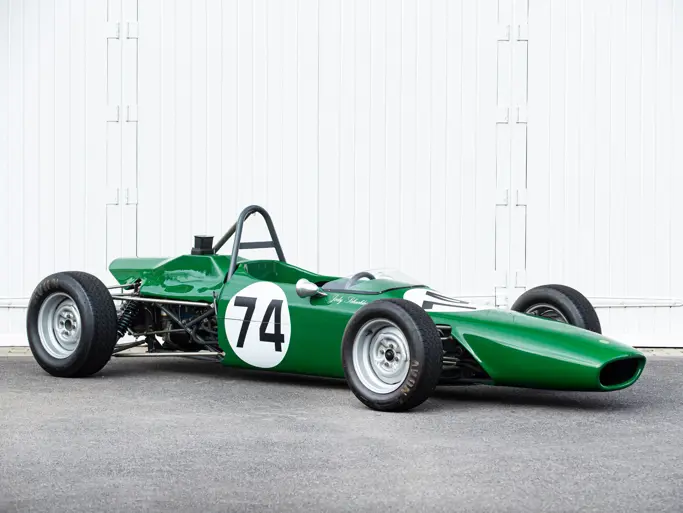426-cid, 425-hp Hemi eight-cylinder engine, three-speed TorqueFlite automatic transmission, independent front suspension with torsion bars, live axle rear suspension with leaf springs, four-wheel drum brakes. Wheelbase: 116-inch
Auburn Fall 2013
1966 Plymouth Belvedere Hemi
{{lr.item.text}}
$50,600 USD | Sold
 | Auburn, Indiana
| Auburn, Indiana
{{internetCurrentBid}}
{{internetTimeLeft}}

- 426-cid, 425-hp Hemi eight-cylinder engine
- Three-speed TorqueFlite automatic transmission
- Independent front suspension with torsion bars
- Live axle rear suspension with leaf springs
- Four-wheel drum brakes
Chrysler responded to the domination of Pontiac, Chevrolet and Ford successes in NASCAR with a dramatic move in 1964. The wedge head 413 and 426 Mopars which replaced the Hemi in 1959 proved successful for a while and remained dominant on drag strips, but came up short when competing against the most recent evolutions of GM’s and Ford’s big block V-8s on NASCAR ovals. Chrysler’s engineering staff took a look at the resources it had at its disposal to deal with this unacceptable situation and creatively modified the 413 Raised Block engine to operate the inclined overhead valves of Chrysler’s Hemi cylinder head. The Hemi had been Chrysler’s answer to an earlier challenge from inline pushrod overhead valve V-8 engines from Cadillac and Lincoln. With typical engineering emphasis, Chrysler’s Fred Zeder chose the hemispherical combustion chamber design for its superior breathing and thermal efficiency even though its dual rocker shaft design brought higher manufacturing costs as a consequence.
The original Chrysler Hemi built an enviable reputation for performance and reliability but in the late ‘50s its cost handicap moved Chrysler to replace it with less expensive wedge head engines. When Lynn Townsend became Chrysler’s President in 1961 the performance of the Mopars on the NASCAR circuit became a priority and in 1962 Chrysler engineering was directed to develop an engine to bring Plymouth and Dodge back to the front of the NASCAR pack. They chose to modify the 413/426 Raised Block to accept Hemi heads, creating the legendary 426 Hemi. While the 426 Hemi’s legacy came directly from the 413/426 RB Wedge and 392 Hemi, it was in fact a completely new engine sharing virtually nothing with its predecessors. Chrysler focused engine development on both power and reliability, developing oval and drag racing versions of the 426 Hemi simultaneously. The 426 Hemi won its first oval track race, the 1964 Daytona 500, with Richard Petty at the wheel of a Plymouth. It was followed across the line by two more Plymouths driven by Jim Pardue and Paul Goldsmith, with Jim Paschal fifth in a Hemi-powered Dodge. Of ten 426 Hemis in the field only one failed to finish because of an engine problem, an amazing finishing rate for a new engine in its first race. The 426 Hemi went from strength to strength both on ovals and drag strips, but these were toolroom-built racing engines and their dominance, along with the Ford single overhead camshaft 427, led NASCAR to institute minimum production requirements for the 1966 season.
The SOHC 427 was too expensive even to consider production but Chrysler had the experience to build the Hemi at reasonable cost and this opened up an opportunity to put Hemis in the hands of truly performance-crazed private owners. The first of these were introduced in early 1966 and were rated at the same 425 horsepower as the oval and drag strip engines despite having lower compression ratio (10.25:1 against the 11:1 or 12.5:1 of the race engines) and it is likely that all these engines made even more power than that. Available in 1966 only in the redesigned Belvedere/Satellite mid-sized 116-inch wheelbase chassis, at $1,105 the “Street Hemi” cost nearly half as much as the basic V-8 Belvedere.
The 1966 Plymouth Belvedere offered here was ordered at the beginning of the model year specifically to make waves at local drags. One of the earliest Street Hemis delivered, its front fenders bear the “HP2” emblem that was fitted only to these early cars. Later Hemis were badged “HEMI” to make their performance prowess more prominent. Installed in the lightest body available, the two-door sedan which weighed some 80 pounds less than the more stylish hardtop, it is one of only 56 built with the high performance 727B TorqueFlite automatic. Its buyer’s dedication to performance was evident in its other options: not only are there none installed but even the heater and radio were deleted to keep weight to a minimum. Subsequently sold and repainted gray, it was retired in 1971 but carefully stored in climate-controlled conditions. The next owner acquired it in 1991 and began a careful restoration. It was repainted in the original Scorch Red color and the original red vinyl interior restored. The engine was rebuilt and blueprinted, adding a Reed .585-inch lift cam, Crane roller lifters and a high capacity oil pan. The crank is a Kellogg NASCAR-spec item and the pistons were replaced with 11.5:1 compression TRWs, but the stock Carter four-barrels were retained. The rear axle is a 4.11:1 Sure Grip. It rides on a set of factory steel wheels with “dog dish” hubcaps fitted with blueline tires and auxiliary engine gauges were added to protect the precious Hemi engine. The HP2 Belvedere’s history is abundantly evident in its mileage. When restoration began it had only something like 2,500 miles; low mileage in absolute terms, but as many as a thousand passes at the drag strip. It has what are believed to be 4,000 miles from new, has won an AACA Senior award for its restoration and took first place at the Mopar Grand Nationals and is presented in show-ready condition.
One of the first of the legendary Street Hemis built, remarkable originality and an award-winning restoration, this 1966 Plymouth Belvedere I HP2 will be an important addition to any collection of American muscle or the ideal example of its genre in a diverse collection. It also is positively breathtaking to drive, and a few more miles (or passes at the strip) will have negligible effect upon its value or presentation.





